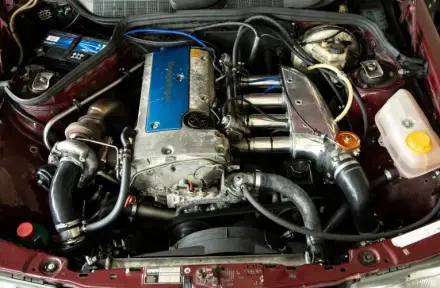
The M111 is a four-cylinder gasoline engine developed by Mercedes-Benz, introduced to the market in 1992 and first used in the C-Class W202. This power unit was available both as a classic naturally aspirated gasoline engine and with supercharger induction.
The timing is controlled by a robust duplex timing chain, aimed at optimizing fuel consumption and performance. Additionally, the series features variable camshaft timing on the intake side. In 2000, the M111 was technically revised and supplemented with the suffix "EVO" (M111 EVO). Its successor is the M271.
Mercedes M111 Engine - Common Breakdowns
The M111 is renowned for its near indestructibility. However, this engine is not without its problems. Below, we discuss the most common weaknesses of the series.
Oil in the Wiring Harness

Over time, the camshaft adjuster's solenoid becomes leaky. This can lead to oil seeping into the wiring harness through capillary action, potentially reaching and damaging the engine control unit.
While damage to the engine control unit is not inevitable, the risk increases with every additional drop of oil. However, this weakness can be fixed with an oil-stop cable, available for a small amount of money and easy to install (Part number: A2711502733). To stop oil loss in the area of the camshaft adjuster, it is also advisable to replace the solenoid valve.
Defective Cylinder Head Gasket

Another typical weakness of the M111 is its cylinder head gasket. Over time, it becomes leaky, often around 93,000 miles. A defect usually announces itself with the loss of coolant.
Defective Supercharger
The supercharged variant of the M111 uses an Eaton supercharger (M62, M45 in the EVO), which generally functions flawlessly. However, as many engines in this series have high mileage, it can be expected that the supercharger will eventually reach its wear limit (around 155,000 miles) and will need replacement or refurbishment.
Leaky Fuel Pressure Regulator
Occasionally, the fuel pressure regulator becomes leaky. A typical symptom is a pervasive gasoline smell in the cabin, especially noticeable after longer drives. This can be easily checked by opening the hood and observing the fuel pressure regulator, located on the fuel rail, while the engine is running. If it's leaky, gasoline will likely drip from the regulator.
Camshaft Adjuster Noise

The camshaft adjuster in the M111 tends to make a clacking noise during cold starts (similar to the sound in this YouTube video). This noise usually occurs during engine cold starts and can be easily mistaken for a rattling timing chain. While the latter indicates impending engine damage, the clacking noise of the camshaft adjuster is harmless and can be ignored.
Mercedes M111 Engine Specs
| Series | Displacement | Power | Torque | Introduction |
| M111 E18 | 1,799 cc | 90 kW (122 hp) / 5,500 RPM | 170 Nm / 4,200 RPM | 1993 |
| M111 E18 | 1,799 cc | 90 kW (122 hp) / 5,500 RPM | 170 Nm / 3,700 RPM | 1997 |
| M111 E20 | 1,998 cc | 95 kW (129 hp) / 5,100 RPM | 186 Nm / 3,600 RPM | 1996 |
| M111 E20 | 1,998 cc | 100 kW (136 hp) / 4,000 RPM | 190 Nm / 4,000 RPM | 1992 |
| M111 E20 | 1,998 cc | 100 kW (136 hp) / 4,000 RPM | 190 Nm / 3,700 RPM | 1997 |
| M111 E20 ML | 1,998 cc | 132 kW (180 hp) / 5,400 RPM | 250 Nm / 2,500 – 4,800 RPM | 1995 |
| M111 E20 ML | 1,998 cc | 137 kW (186 hp) / 5,400 RPM | 270 Nm / 2,500 – 4,800 RPM | 1996 |
| M111 E22 | 2,199 cc | 110 kW (150 hp) / 5,400 RPM | 210 Nm / 4,000 RPM | 1992 |
| M111 E23 | 2,295 cc | 105 kW (143 hp) / 5,000 RPM | 210 Nm / 4,000 RPM | 1996 |
| M111 E23 | 2,295 cc | 105 kW (143 hp) / 5,000 RPM | 215 Nm / 3,500 RPM | 1999 |
| M111 E23 | 2,295 cc | 110 kW (150 hp) / 5,400 RPM | 220 Nm / 3,700 RPM | 1995 |
| M111 E23 | 2,295 cc | 110 kW (150 hp) / 5,400 RPM | 220 Nm / 3,800 RPM | 1995 |
| M111 E23 ML | 2,295 cc | 142 kW (193 hp) / 5,300 RPM | 280 Nm / 2,500 – 4,800 RPM | 1995 |
Mercedes M111 Evo Engine Specs
| Series | Displacement | Power | Torque | Introduction |
| M111 E20 EVO | 1,998 cc | 95 kW (129 hp) / 5,500 RPM | 185 Nm / 3,500 RPM | 2000 |
| M111 E20 ML EVO | 1,998 cc | 120 kW (163 hp) / 5,500 RPM | 230 Nm / 2,500 – 4,800 RPM | 2000 |
| M111 E23 ML EVO | 2,295 cc | 144 kW (197 hp) / 5,500 RPM | 280 Nm / 2,500 – 5,000 RPM | 2000 |
Conclusion
The M111 is a bastion of reliability and, with regular maintenance, is almost indestructible. As long as the aforementioned weaknesses do not stand out during the inspection of the vehicle and the car overall makes a good impression, one can confidently choose any Daimler with this engine. Those seeking maximum durability should opt for a non-supercharged variant, as these are generally less abused.
See Also:
Same articles

Understanding Vehicle Inspection and Verification Services: Why They Matter for Every Driver
GuidesVehicle inspection and verification services are an essential but often overlooked part of keeping roads safe and cars legally compliant. Most people only think about inspections when it’s...

Anonymous Cryptocurrency Exchange: Unlocking Confidential, Flexible Crypto Trading in 2025
GuidesThe concept of an "anonymous cryptocurrency exchange" has become a focal point in the digital asset world as privacy, user autonomy, and security have...

Renting a Car: What Do You Need to Know
GuidesEmbarking on the journey of renting a car for the first time can be akin to navigating uncharted waters. It's a path many have traversed, driven by the need for convenience, exploration, or...

